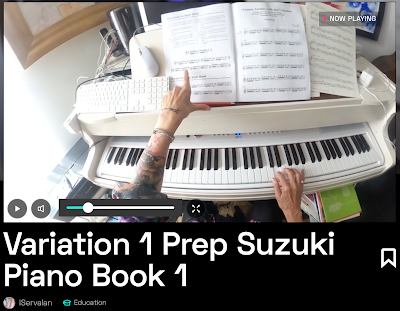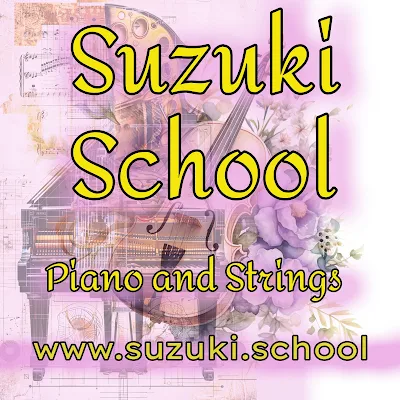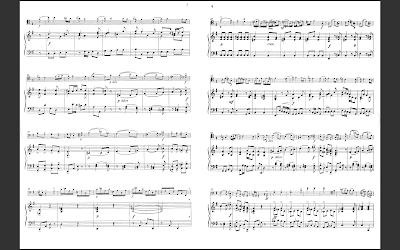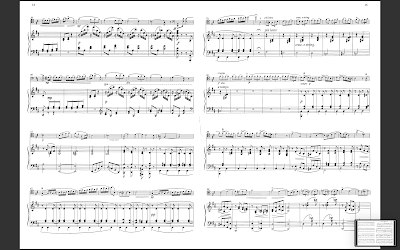Tuesday, May 14, 2024
Monday, May 13, 2024
What makes the piano a great choice for first instrument lessons for all ages?
The piano is an excellent choice for a first instrument, and here’s why:
Ease of Play: The piano is physically easier to play compared to many other instruments. Its straightforward keyboard layout allows beginners to understand note arrangements easily12.
Simplicity in Sound: Making music on the piano is simpler. Unlike some instruments that require specific fingerings or embouchure techniques, the piano produces sound by pressing keys, making it more accessible for beginners1.
Versatility: The piano’s unmatched versatility spans various genres, from classical to jazz to pop. Its full range of notes allows for complex melodies and harmonies, making it an ideal choice for beginners who want to explore different styles1.
Cognitive Benefits: Learning the piano enhances cognitive skills, improves coordination, and provides a solid foundation in music theory. Plus, it can make learning other instruments easier later on13.
In summary, the piano’s ease of play, versatility, and cognitive benefits make it an ideal first instrument for aspiring musicians! 🎹🎶143.
How to practice and perfect your scales for string instruments
- Use strong and articulated fingers for better precision and intonation.
- Train your ears to hear the correct notes and fix the wrong ones.
- Anticipate the next note with your left hand and brain.
- Make quick, light, and smooth shiftings or position changes.
- Use equal and precise bow distribution, regardless of the tempo.
- Play scales musically, as if they were pieces of repertoire.
- Warm-up with scales before starting your practice.
- Practice consistently and regularly, even if it’s only 15 minutes a day.
- Set realistic goals and talk to your teacher about your progress.
- Take breaks and avoid frustration.
- Find a good teacher or coach who can guide you and keep you accountable.
Also, consider practicing scale cycle exercises that cover 2 octaves and up to 3 sharps & flats. This will help you understand note relationships, improve your intonation, and build finger strength and dexterity.
Some tips for advanced cellists to practice scales:
- Expand your range: Practice scales that cover 4 octaves, all sharp & flat keys, and alternate between major and harmonic minor scales.
- Use full bows: Play whole notes on each scale tone, ensuring that you stay on the contact point when you change bow direction.
- Practice intervals: Start by playing single notes, then move to two-note intervals, and then finally three-note intervals. This will help you become more comfortable with the scale and also increase your speed and dexterity.
- Warm-up exercises: Begin with warm-up exercises, such as scales, to engage your fingers and your mind.
- Focused practice: Follow your warm-up with focused practice on pieces or techniques you’re learning.
- Finish with something enjoyable: Perhaps a piece you love or some free playing.
- Consistency is key: Remember, it’s okay to have slow days; the aim is to keep going.
Watch 30 lessons a month for the same price as a single music lesson #suzuki #cello #piano #viola #bass
Our New TV Station for Piano and Strings with iServalan
Such a great day as I uploaded my first lessons in Suzuki piano and cello.
Pop over and watch on demand as you need them.
Sunday, May 12, 2024
Saturday, May 4, 2024
Thursday, May 2, 2024
Learning the viola can be a rewarding experience. Here are some tips for beginners to help you get started:
Learning the viola can be a rewarding experience. Here are some tips for beginners to help you get started:
Schedule Practice for Peak Energy: Plan your practice sessions during the time of day when you feel most energetic. If you’re a morning person, practice then; if your energy peaks in the afternoon, schedule your practice during that window1.
Create a Distraction-Free Practice Area: Keep your practice space clutter-free and free from distractions. Silence your phone, tidy up, and have everything you need at hand. A focused practice environment leads to better results1.
Practice Frequently: Consistency matters more than duration. Opt for shorter, frequent practice sessions rather than longer, infrequent ones. Studies show that practicing more often leads to better overall improvement1.
Warm Up Before Playing: Playing the viola involves repetitive movements that strain specific muscles. Warm up those muscles before practicing to prevent injuries. Even simple finger stretches can help1.
Record Yourself and Listen: Recording your practice sessions allows you to hear areas that need improvement. Put yourself in your audience’s shoes and identify what needs work. Most smartphones have built-in audio recorders, or you can find free apps in app stores1.
Use a Metronome: Timing and rhythm are crucial. A metronome is an excellent tool for practicing both. If you don’t have one, you can use free online metronomes on your desktop or mobile1.
Avoid Constantly Looking at Your Fingers: While it’s natural for beginners to watch their fingers, try to look ahead at your sheet music or focus on an object in the room. Connecting your hearing with finger position leads to better pitch accuracy and a more polished performance1.
Perform Whenever Possible: Performing in front of others counts as practice under pressure. It’s also a great way to build confidence and improve your overall playing skills1.
Remember, learning any instrument takes time and patience. Enjoy the process, and don’t hesitate to seek guidance from a teacher or experienced violist. Happy playing! 🎻🎶123
Suzuki School, what is it and how can it help you?
The Suzuki School is a place for budding musicians who want to learn to master their instruments. But it is also a space for fun and connecting with your tutor, Sarnia de la Maré FRSA. You can also ask questions about anything related to your playing because sometimes we us musicians come across the simple and the complicated issues we struggle with.
If you want more help you can book one to one lessons in piano, cello and viola whenever you need them without signing up for a full term.
We also offer jazz and ABRSM courses.
But first, let's find out about the Suzuki method.
The Suzuki Method is a music curriculum and teaching philosophy developed by the Japanese violinist, pedagogue, educator, and humanitarian, Dr. Shinichi Suzuki. Here are the key aspects of this method:
Listening and Repetition:
- The Suzuki method emphasizes the importance of listening to music extensively. Students are encouraged to listen to recordings of the pieces they are learning.
- Repetition is a fundamental practice. Students play the same piece repeatedly to internalize the music and improve their skills.
Parental Involvement:
- Parents or guardians play an active role in their child’s music education. They attend lessons, take notes, and guide practice sessions at home.
- Dr. Suzuki believed that a supportive environment at home is crucial for a child’s musical development.
Sequential Repertoire:
- All Suzuki students follow the same sequence and choice of musical materials for their particular instrument.
- Each Suzuki School instrument has its own repertoire. Beginning with Volume I, the child masters each new composition, moving carefully forward, acquiring new skills with each piece that prepares them for the ones to follow1.
Positive Reinforcement:
- The method creates a reinforcing environment for learning music.
- Encouragement, praise, and positive feedback are essential to motivate students and build their confidence.
Every Child Can:
- Dr. Suzuki’s philosophy is encapsulated in the phrase “Every child can.”
- He believed that musical ability is not innate but can be nurtured through proper teaching, practice, and exposure to music.
The Suzuki Method has been widely used around the world and has helped many children learn to play instruments, particularly the violin, at a high level23. If you’re interested in exploring this approach further, consider connecting with the British Suzuki Music Association, which trains teachers in the Suzuki Method and supports families involved in the Suzuki movement4. 🎻



























